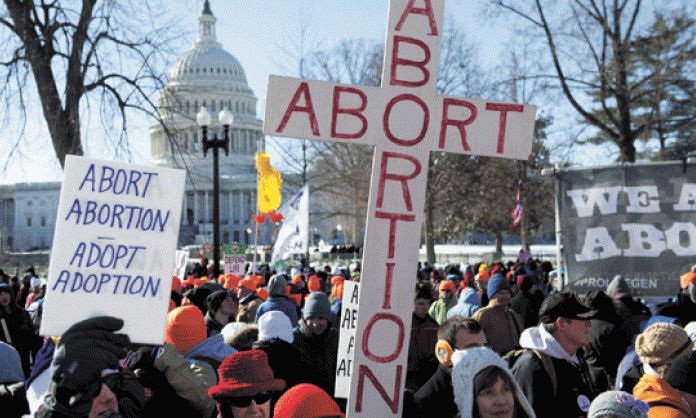A new wave of restrictions on abortions, spearheaded by Republicans, is being implemented in the US.
The Republican-controlled House of Representatives recently passed a bill banning most abortions after 20 weeks of pregnancy.
While the bill will probably not pass the Senate, and president Obama has promised a veto if it does, the Republicans are sending a message that they intend to wipe out the hard-won gains of the women’s liberation movement.
In 2010, they made electoral gains in many states. Since then, there has been a steady increase, in Republican-controlled states, in laws that severely restrict the right to abortion. Eleven states have passed 37 new anti-abortion laws in the first five months of this year.
The laws include mandatory waiting periods, limits on later-term abortions, severe restrictions on abortion clinics, banning certain abortion medical procedures, mandatory “counselling” of women seeking an abortion to discourage them from the procedure, forcing women to view ultrasounds of their foetuses and mandatory requirements that underage women gain parental consent.
In many of these states, clinics have been forced to close. Many women must travel hundreds of miles to find a clinic – a special hardship for working class women, who have to take time off work and find transportation. Mandatory waiting periods, which require two or more visits, make it even more difficult.
Wealthier women can avoid local restrictions by travelling to other states or other countries where there are less onerous laws.
The Democrats point the finger at the Republicans in the two-party shell game that is US politics. But they make zero effort to introduce bills to retake lost ground. The real attitude is expressed in their four-decade-long Congressional support for renewing the Hyde Amendment, which bars federal money being used to fund abortions.
This hits poor women the hardest. The federal medical insurance program for the poor, Medicaid, can’t be used for abortions. Insurance covering abortions has to be purchased separately.
Escalation
The current reaction is an escalation of a long campaign to undermine a 1973 Supreme Court decision that legalised most abortions in the US (the historic Roe vs. Wade case).
The 1973 ruling didn’t come out of nowhere, nor was it the result of a sudden change of heart by the nine robed reactionaries sitting on the bench.
It came as a result of the radicalisation of the 1960s-70s. Inspired by the Black liberation and anti-war movements, and the resultant mass youth radicalisation, a militant women’s liberation movement arose. In meetings, marches and other mass actions, on campuses and in the streets, their voices and those of their male supporters were heard louder and louder.
One of the main demands of the movement was the right to abortion, which had been illegal in the US since the second half of the 19th century. This demand was connected to the fight for gender equality, with the observation that women could never be equal if they could not have control over their own bodies.
The movement changed mass consciousness. Between 1967 and 1973, 14 states reformed and four states repealed restrictive abortion laws. A mass campaign was launched in the early 1970s specifically aimed at overturning anti-abortion laws everywhere. Socialists played an important role in launching the campaign, as they had in the anti-war movement.
This was the background to the 1973 decision, which struck down all existing criminal abortion laws. It legalised all abortions in the first trimester of pregnancy. It allowed states to place restrictions in the second trimester to protect a woman’s health and in the third to protect a viable foetus.
However, it also said that if a woman’s life or health were endangered, she could not be forced to continue the pregnancy at any stage.
Since then, there has been a relentless attack on the ruling by anti-abortion forces. Their first success was the Hyde Amendment, passed in 1976, and routinely renewed ever since.
In 1979, the Supreme Court started whittling away at its 1973 ruling. It said that states could force an underage woman to obtain parental consent or persuade a judge to allow her to have an abortion. In the 1980s, it backed the Hyde Amendment, by ruling that payment for abortions could be excluded from Medicaid.
In 1992, the court ruled that a highly restrictive Pennsylvania law, which included mandatory waiting periods, parental consent and anti-abortion propaganda aimed at the woman, was OK. It allowed laws to limit abortion at any stage of pregnancy, abandoning the previous ruling, as long as the laws do not place an “undue burden” on a woman’s access to abortion.
In 2007, the court upheld a law passed by Congress and signed by president Bush, which banned a particular method of abortion used in late term procedures. The ban has forced doctors to choose a less safe procedure. This opened the door to state restrictions on later abortions.
The Republicans have used these decisions to go hog-wild in their attacks, while the Democrats bleat that they can’t do anything because “the law is the law”. That is, they do nothing to try to change the law.
The establishment women’s groups bear much of the blame. The National Organization for Women turned away from mass mobilisations in the 1980s and toward supporting the Democratic Party as the way forward for women’s rights. The National Association for the Repeal of Abortion Laws, which has a good formal position, similarly directs its efforts into lobbying politicians and supporting Democrats.
The result is that the Republicans set the agenda, pushing against abortion rights, while the Democrats are drawn into their wake.










